Dr. Carver Is Dead; Negro ScientistBy THE NEW YORK TIMESTUSKEGEE, Ala., Jan. 5 (AP)--Dr. George Washington Carver, noted Negro scientist, died early tonight in his home at Tuskegee Institute. His age was 78.Dr. Carver had been in failing health for some months and was confined to his bed for the last ten days. He became a member of the Tuskegee Institute faculty in 1894 and had been attached to the Negro institution ever since. Dr. Carver was recognized as one of the outstanding scientists in the field of agricultural research. He discovered scores of uses for such lowly products as sweet potatoes, peanuts and clay. From the South's red clay and sandy loam, he developed ink, pigments, cosmetics, paper, paint, and many other articles. No Ambition for RichesDr. Carver, paying no attention to his clothes and refusing to make money on his discoveries, simply devoted his life to scientific agricultural research, to enable his colored brethren to make a better living from the soil in the South. He became such an authority on cotton, the peanut and the sweet potato that he ended with a place among important white men. His name is in "Who's Who in America," and he was accorded a membership in the Royal Society of London. "Who's Who" lists him as an educator and follows immediately with the information, which he supplied, that he was "born of slave parents on a farm near Diamond Grove, Mo., about 1864; in infancy lost his father and was stolen and carried into Arkansas with mother, who was never heard of again; was bought from captors for a race horse valued at $300 and returned to former home in Missouri." Because he was a puny boy who got his growth late, he was allowed to run around as a household pet without being put to heavy work. Outdoors he learned about trees, shrubs and insects and liked to paint and draw them. In the kitchen he picked up much knowledge of cooking and of canning fruits and vegetables which later was to serve his people. In the parlor he learned something of music. Worked Way Through SchoolUntil he was almost 20 he did not learn to read and write. That came after he grew up suddenly and struck out for himself. He had seen education at close quarters in a white household and felt he could use it. He worked his way through high school in Minneapolis, Kan., and later through the Iowa State College of Agriculture and Mechanic Arts. He was graduated there with the degree of Bachelor of Science in Agriculture in 1894, at the age of 30, and was immediately made a faculty member in charge of the college greenhouse and the bacterial laboratory work in systematic botany. Two years later he had earned the degree of Master of Science and made the acquaintance of Booker T. Washington, who then was bringing the Tuskegee Institute in Alabama to notice. He went to Tuskegee in 1896 and stayed there for the remainder of his life, directing the Department of Agricultural Research. Sand was a great curse then to the Alabama cotton farmer. The short-stalk cotton produced the fattest bolls and the tall-stalk produced the leanest. Yet the short-stalk cotton left the bolls exposed to splashes of sand when it rained. By a crossing process Professor Carver got the fat cotton bolls of the short-stalk cotton to grow on the tall stalks that lifted them out of the sand. Officially in Washington the cross was recognized by the name of "Carver's Hybrid." Champion of DiversificationAfter the boll-weevil invasion had brought misery to the one-crop South, Professor Carver addressed himself to the developing the uses of the peanut and the sweet potato and spreading the gospel of diversification with these also as money crops. He developed more than a hundred different products from the peanut, including milk, ink, flour, breakfast foods, wood stains, face creams and, latterly, a medicinal peanut oil which was found helpful in the treatment of infantile paralysis. When he produced an array of these products before the Ways and Means Committee of Congress in 1921, in support of a protective duty on peanuts, John N. Garner, then a Representative from Texas, pronounced it "a most wonderful exhibition." Professor Carver developed almost as many diversified uses for the sweet potato, from which he produced tapioca, molasses, dyes, coffee, starch, as well as flour. His researches into the possibility of making rubber from sweet potatoes attracted the attention of Thomas A. Edison, who invited him to move them to Orange, N. J., at a salary representing a princely advance over Tuskegee. Professor Carver declined. "Revelation From God"He likewise declined to accept $100 which a manufacturer sent him in acknowledgment of one of his peanut discoveries which the manufacturer had put to use. "My discoveries come like a direct revelation from God," he said in explanation of his attitude, addressing the annual meeting of the Women's Board of Domestic Missions of the Reformed Church, at the Marble Collegiate Church in New York in 1924. "The idea and the method of working out a new product come all together," he continued. "In half an hour after the idea was revealed to me, I produced the yolk of an egg from the Puerto Rican sweet potato." He traveled through the South, lecturing to farm gatherings on the better cultivation and utilization of common products, receiving attention and applause not only from Negroes but also from white men, who recognized that he could tell them how to better their farming, their living, their health and their prosperity. In 1923 the National Association for the Advancement of Colored People awarded him the Spingarn Medal for discoveries that would change the economic life of the South. In 1935 he was appointed collaborator in the Bureau of Plant Industry of the United States Department of Agriculture, in the division of plant mycology and disease survey. He was invited frequently to speak before agricultural classes in the white technical colleges of the South. A less known side of Professor Carver's activity was his Bible class at Tuskegee, started in 1906, when his office boy and seven other students asked him to teach them the Bible on Sundays. He taught the Bible by impersonating the characters himself. On one occasion he astonished his class when it reached the story of the manna-fed Israelites by producing a variety of the original manna, which he had gathered in the woods about Tuskegee. Dr. Carver received one of the three Roosevelt Medals for 1939. The next year he gave his life savings of $33,000 (they had been depleted by a bank failure) to establish a foundation for research in creative chemistry. Last Summer it was announced that Dr. Carver, an old friend of Henry Ford, would take part in food experiments in the Ford laboratories at Detroit. ____________________________________________________________________________________
George Washington Carver (c. 1860[2][3] – 5 January 1943), was an American botanist and inventor. The exact day and year of his birth are unknown; he was born into slavery in Missouri, either in 1861, or January 1864.[3]
Carver's reputation is based on his research into and promotion of alternative crops to cotton, such as peanuts, soybeans, and sweet potatoes, which also aided nutrition for farm families. He wanted poor farmers to grow alternative crops both as a source of their own food and as a source of other products to improve their quality of life. The most popular of his 44 practical bulletins for farmers contained 105 food recipes using peanuts.[4] He also developed and promoted about 100 products made from peanuts that were useful for the house and farm, including cosmetics, dyes, paints, plastics, gasoline, and nitroglycerin. He received numerous honors for his work, including the Spingarn Medal of the NAACP.
During the Reconstruction-era South, monoculture of cotton depleted the soil in many areas. In the early 20th century, the boll weevil destroyed much of the cotton crop, and planters and farm workers suffered. Carver's work on peanuts was intended to provide an alternative crop.
He was recognized for his many achievements and talents. In 1941, Time magazine dubbed Carver a "Black Leonardo".[5]
Contents[hide]Early years
Carver was born into slavery in Diamond Grove, Newton County, near Crystal Place, now known as Diamond, Missouri, possibly in 1864 or 1865, though the exact date is not known.[6][7] His master, Moses Carver, was a German American immigrant who had purchased George's parents, Mary and Giles, from William P. McGinnis on October 9, 1855, for $700. Carver had 10 sisters and a brother, all of whom died prematurely.[citation needed]
When George was only a week old, he, a sister, and his mother were kidnapped by night raiders from Arkansas.[8] George's brother, James, was rushed to safety from the kidnappers.[8] The kidnappers sold the slaves in Kentucky. Moses Carver hired John Bentley to find them, but he located only the infant George. Moses negotiated with the raiders to gain the boy's return,[8] and rewarded Bentley.
After slavery was abolished, Moses Carver and his wife Susan raised George and his older brother James as their own children.[8] They encouraged George to continue his intellectual pursuits, and "Aunt Susan" taught him the basics of reading and writing.
Black people were not allowed at the public school in Diamond Grove. Learning there was a school for black children 10 miles (16 km) south in Neosho, George decided to go there. When he reached the town, he found the school closed for the night. He slept in a nearby barn. By his own account, the next morning he met a kind woman, Mariah Watkins, from whom he wished to rent a room. When he identified himself as "Carver's George," as he had done his whole life, she replied that from now on his name was "George Carver". George liked Mariah Watkins, and her words, "You must learn all you can, then go back out into the world and give your learning back to the people", made a great impression on him.[citation needed]
At the age of thirteen, due to his desire to attend the academy there, he relocated to the home of another foster family in Fort Scott, Kansas. After witnessing a black man killed by a group of whites, Carver left the city. He attended a series of schools before earning his diploma at Minneapolis High School in Minneapolis, Kansas.
College
Carver applied to several colleges before being accepted at Highland College in Highland, Kansas. When he arrived, however, they rejected him because of his race. In August 1886, Carver traveled by wagon with J. F. Beeler from Highland to Eden Township in Ness County, Kansas.[9] He homesteaded a claim[10] near Beeler, where he maintained a small conservatory of plants and flowers and a geological collection. He manually plowed 17 acres (69,000 m2) of the claim, planting rice, corn, Indian corn and garden produce, as well as various fruit trees, forest trees, and shrubbery. He also earned money by odd jobs in town and worked as a ranch hand.[9]
In early 1888, Carver obtained a $300 loan at the Bank of Ness City for education. By June he left the area.[9] In 1890, Carver started studying art and piano at Simpson College inIndianola, Iowa.[11] His art teacher, Etta Budd, recognized Carver's talent for painting flowers and plants; she encouraged him to study botany at Iowa State Agricultural College inAmes.[11] When he began there in 1891, he was the first black student. Carver's Bachelor's thesis was "Plants as Modified by Man", dated 1894.[12]
Iowa State professors Joseph Budd and Louis Pammel convinced Carver to continue there for his master's degree. Carver did research at the Iowa Experiment Station under Pammel during the next two years. His work at the experiment station in plant pathology and mycology first gained him national recognition and respect as a botanist. Carver taught as the first black faculty member at Iowa State.
Tuskegee Institute
In 1896, Booker T. Washington, the first principal and president of the Tuskegee Institute, invited Carver to head its Agriculture Department. Carver taught there for 47 years, developing the department into a strong research center and working with two additional college presidents during his tenure. He taught methods of crop rotation, introduced several alternative cash crops for farmers that would also improve the soil of areas heavily cultivated in cotton, initiated research into crop products (chemurgy), and taught generations of black students farming techniques for self-sufficiency.
Carver designed a mobile classroom to take education out to farmers. He called it a "Jesup wagon" after the New York financier and philanthropist Morris Ketchum Jesup, who provided funding to support the program.[13]
To recruit Carver to Tuskegee, Washington gave him an above average salary and two rooms for his personal use, both of which concessions were resented by some other faculty. Because he had earned a master's in a scientific field from a "white" institution, some faculty perceived him as arrogant when a young man.[14] Unmarried faculty members normally had to share rooms, with two to a room, in the spartan early days of the institute.
One of Carver's duties was to administer the Agricultural Experiment Station farms. He had to manage the production and sale of farm products to generate revenue for the Institute. He soon proved to be a poor administrator. In 1900, Carver complained that the physical work and the letter-writing required were too much.[15] In 1904, an Institute committee reported that Carver's reports on yields from the poultry yard were exaggerated, and Washington confronted Carver about the issue. Carver replied in writing, "Now to be branded as a liar and party to such hellish deception it is more than I can bear, and if your committee feel that I have willfully lied or [was] party to such lies as were told my resignation is at your disposal."[16] During Washington's last five years at Tuskegee, Carver submitted or threatened his resignation several times: when the administration reorganized the agriculture programs,[17] when he disliked a teaching assignment,[18] to manage an experiment station elsewhere,[19] and when he did not get summer teaching assignments in 1913-1914.[20][21] In each case, Washington smoothed things over.
Carver started his academic career as a researcher and teacher. In 1911, Washington wrote a letter to him complaining that Carver had not followed orders to plant particular crops at the experiment station. This revealed Washington's micro-management of Carver's department, which he had headed for more than 10 years by then. Washington at the same time refused Carver's requests for a new laboratory, research supplies for his exclusive use, and respite from teaching classes. Washington praised Carver's abilities in teaching and original research but said about his administrative skills:
In 1911, Carver complained that his laboratory had not received the equipment which Washington had promised 11 months before. He also complained about Institute committee meetings.[22] Washington praised Carver in his 1911 memoir, My Larger Education: Being Chapters from My Experience.[23] Washington called Carver "one of the most thoroughly scientific men of the Negro race with whom I am acquainted." [24] After Washington died in 1915, his successor made fewer demands on Carver for administrative tasks.
While a professor at Tuskegee, Carver joined the Gamma Sigma chapter of Phi Beta Sigma fraternity. He spoke at the 1930 Conclave that was held at Tuskegee, Alabama, in which he delivered a powerful and emotional speech to the men in attendance.[25]
From 1915 to 1923, Carver concentrated on researching and experimenting with new uses for peanuts, sweet potatoes, soybeans, pecans, and other crops, as well as having his assistants research and compile existing uses.[26] This work, and especially his speaking to a national conference of the Peanut Growers Association in 1920 and in testimony before Congress in 1921 to support passage of a tariff on imported peanuts, brought him wide publicity and increasing renown. In these years, he became one of the most well-known African Americans of his time.
Rise to fame
Carver developed techniques to improve soils depleted by repeated plantings of cotton. Together with other agricultural experts, he urged farmers to restorenitrogen to their soils by practicing systematic crop rotation: alternating cotton crops with plantings of sweet potatoes or legumes (such as peanuts, soybeans andcowpeas). These both restored nitrogen to the soil and the crops were good for human consumption. Following the crop rotation practice resulted in improved cotton yields and gave farmers alternative cash crops. To train farmers to successfully rotate and cultivate the new crops, Carver developed an agricultural extension program for Alabama that was similar to the one at Iowa State. To encourage better nutrition in the South, he widely distributed recipes using the alternative crops.
In addition, he founded an industrial research laboratory, where he and assistants worked to popularize the new crops by developing hundreds of applications for them. They did original research as well as promoting applications and recipes which they collected from others. Carver distributed his information as agricultural bulletins. (See Carver bulletins below.)
Carver's work was known by officials in the national capital before he became a public figure. President Theodore Rooseveltpublicly admired his work. Former professors of Carver's from Iowa State University were appointed to positions as Secretary of Agriculture: James Wilson, a former dean and professor of Carver's, served from 1897 to 1913. Henry Cantwell Wallaceserved from 1921 to 1924. He knew Carver personally as his son Henry A. Wallace and the researcher were friends.[27] The younger Wallace served as U.S. Secretary of Agriculture from 1933 to 1940, and as Franklin Delano Roosevelt's vice president from 1941 to 1945.
The American industrialist, farmer, and inventor William Edenborn of Winn Parish, Louisiana, grew peanuts on his demonstration farm. He consulted with Carver.[28]
In 1916 Carver was made a member of the Royal Society of Arts in England, one of only a handful of Americans at that time to receive this honor. Carver's promotion of peanuts gained him the most notice. In 1919, Carver wrote to a peanut company about the potential he saw for peanut milk. Both he and the peanut industry seemed unaware that in 1917 William Melhuish had secured patent #1,243,855 for a milk substitute made from peanuts and soybeans.
The United Peanut Associations of America invited Carver to speak at their 1920 convention. He discussed "The Possibilities of the Peanut" and exhibited 145 peanut products. By 1920, the U.S. peanut farmers were being undercut by low prices on imported peanuts from the Republic of China.
In 1921 peanut farmers and industry representatives planned to appear at Congressional hearings to ask for a tariff. Based on the quality of Carver's presentation at their convention, they asked the African-American professor to testify on the tariff issue before the Ways and Means Committee of the United States House of Representatives. Due to segregation, it was highly unusual for an African American to appear as an expert witness at Congress representing European-American industry and farmers. Southern congressmen, reportedly shocked at Carver's arriving to testify, were said to have mocked him.[citation needed] As he talked about the importance of the peanut and its uses for American agriculture, the committee members repeatedly extended the time for his testimony. The Fordney-McCumber Tariff of 1922 was passed including one on imported peanuts. Carver's testifying to Congress made him widely known as a public figure.
Life while famous
During the last two decades of his life, Carver seemed to enjoy his celebrity status. He was often on the road promoting Tuskegee University, peanuts, and racial harmony. Although he only published six agricultural bulletins after 1922, he published articles in peanut industry journals and wrote a syndicated newspaper column, "Professor Carver's Advice". Business leaders came to seek his help, and he often responded with free advice. Three American presidents—Theodore Roosevelt, Calvin Coolidge and Franklin Roosevelt—met with him, and the Crown Prince of Sweden studied with him for three weeks. From 1923 to 1933, Carver toured white Southern colleges for the Commission on Interracial Cooperation.[26]
With his increasing notability, Carver became the subject of biographies and articles. Raleigh H. Merritt contacted him for his biography published in 1929. Merritt wrote,
In 1932 the writer James Saxon Childers wrote that Carver and his peanut products were almost solely responsible for the rise in U.S. peanut production after the boll weevildevastated the American cotton crop beginning about 1892. His article, "A Boy Who Was Traded for a Horse" (1932), in The American Magazine, and its 1937 reprint inReader's Digest, contributed to this myth about Carver's influence. Other popular media tended to exaggerate Carver's impact on the peanut industry.[30]
From 1933 to 1935, Carver worked to develop peanut oil massages to treat infantile paralysis (polio).[26] Ultimately researchers found that the massages, not the peanut oil, provided the benefits of maintaining some mobility to paralyzed limbs.
From 1935 to 1937, Carver participated in the USDA Disease Survey. Carver had specialized in plant diseases and mycology for his master's degree.
In 1937, Carver attended two chemurgy conferences, an emerging field in the 1930s, during the Great Depression and the Dust Bowl, concerned with developing new products from crops.[26] He was invited by Henry Ford to speak at the conference held in Dearborn, Michigan, and they developed a friendship. That year Carver's health declined, and Ford later installed an elevator at the Tuskegee dormitory where Carver lived, so that the elderly man would not have to climb stairs.[5][31]
Carver had been frugal in his life, and in his seventies established a legacy by creating a museum on his work and the George Washington Carver Foundation at Tuskegee in 1938 to continue agricultural research. He donated nearly $60,000 in his savings to create the foundation.[31]
Legacy and honors
Personal life
Carver never married. At age forty, he began a courtship with Sarah L. Hunt, an elementary school teacher and the sister-in-law of Warren Logan, Treasurer of Tuskegee Institute. This lasted three years until she took a teaching job in California.[38] In her 2015 biography, Christina Vella reviews his relationships and suggests that Carver was bisexual and constrained by mores of his historic period.[39]
When he was seventy, Carver established a friendship and research partnership with the scientist Austin W. Curtis, Jr. This young white man, a graduate of Cornell University, had some teaching experience before coming to Tuskegee. Carver bequeathed to Curtis his royalties from an authorized 1943 biography by Rackham Holt.[40]
After Carver died in 1943, Curtis was fired from Tuskegee Institute. He left Alabama and resettled in Detroit. There he manufactured and sold peanut-based personal care products.[41]
Death and legacy
Upon returning home one day, Carver took a bad fall down a flight of stairs; he was found unconscious by a maid who took him to a hospital. Carver died January 5, 1943, at the age of 78 from complications (anemia) resulting from this fall. He was buried next to Booker T. Washington at Tuskegee University. Due to his frugality, Carver's life savings totaled $60,000, all of which he donated in his last years and at his death to the Carver Museum and to the George Washington Carver Foundation.[42]
On his grave was written, He could have added fortune to fame, but caring for neither, he found happiness and honor in being helpful to the world.
A movement to establish a U.S. national monument to Carver began before his death. Because of World War II, such non-war expenditures had been banned by presidential order. Missouri senator Harry S. Truman sponsored a bill in favor of a monument. In a committee hearing on the bill, one supporter said:
The bill passed unanimously in both houses.
On July 14, 1943,[43] President Franklin D. Roosevelt dedicated $30,000 for the George Washington Carver National Monument west-southwest of Diamond, Missouri, the area where Carver had spent time in his childhood. This was the first national monument dedicated to an African American and the first to honor someone other than a president. The 210-acre (0.8 km2) national monument complex includes a bust of Carver, a ¾-mile nature trail, a museum, the 1881 Moses Carver house, and the Carver cemetery. The national monument opened July 1953.
In December 1947, a fire broke out in the Carver Museum, and much of the collection was damaged. Time magazine reported that all but three of the 48 Carver paintings at the museum were destroyed. His best-known painting, displayed at the World's Columbian Exposition of 1893 in Chicago, depicts a yucca and cactus. This canvas survived and has undergone conservation. It is displayed together with several of his other paintings.[44]
Carver was featured on U.S. 1948 commemorative stamps. From 1951 to 1954, he was depicted on a commemorative half dollar coin. A second stamp honoring Carver, of face value 32¢, was issued on 3 February 1998 as part of the Celebrate the Century stamp sheet series. Two ships, the Liberty ship SS George Washington Carver and thenuclear submarine USS George Washington Carver (SSBN-656), were named in his honor.
In 1977, Carver was elected to the Hall of Fame for Great Americans. In 1990, Carver was inducted into the National Inventors Hall of Fame. In 1994, Iowa State University awarded Carver a Doctor of Humane Letters. In 2000, Carver was a charter inductee in the USDA Hall of Heroes as the "Father of Chemurgy".[45]
In 2002, scholar Molefi Kete Asante listed George Washington Carver as one of 100 Greatest African Americans.[46]
In 2005, Carver's research at the Tuskegee Institute was designated a National Historic Chemical Landmark by the American Chemical Society.[47] On February 15, 2005, an episode of Modern Marvels included scenes from within Iowa State University's Food Sciences Building and about Carver's work. In 2005, the Missouri Botanical Garden in St. Louis, Missouri, opened a George Washington Carver garden in his honor, which includes a life-size statue of him.
Many institutions continue to honor George Washington Carver. A garden and statue of him are dedicated in the noted Missouri Botanical Gardens in St. Louis. Dozens of elementary schools and high schools are named after him. National Basketball Association star David Robinson and his wife, Valerie, founded an academy named after Carver; it opened on September 17, 2001, in San Antonio, Texas.[48] The Carver Community Cultural Center, a historic center located in San Antonio, is named for him.
Reputed inventions
George Washington Carver reputedly developed 300 uses for peanuts and hundreds more for soybeans, pecans and sweet potatoes. Among the uses that he suggested to southern farmers to help them economically were adhesives, axle grease, bleach, buttermilk, chili sauce, fuel briquettes (a biofuel), ink, instant coffee, linoleum, mayonnaise, meat tenderizer, metal polish, paper, plastic, pavement, shaving cream,shoe polish, synthetic rubber, talcum powder and wood stain. Three patents (one for cosmetics; patent number 1,522,176, and two for paints and stains; patent numbers 1,541,478 and 1,632,365) were issued to George Washington Carver in the years 1925 to 1927; however, they were not commercially successful.[49] Aside from these patents and some recipes for food, Carver left no records of formulae or procedures for making his products.[50] He did not keep a laboratory notebook.
Carver's research was intended to produce replacements from common crops for commercial products, which were generally beyond the budget of the small one-horse farmer. A misconception grew that his research on products for subsistence farmers were developed by others commercially to change Southern agriculture.[51][52] Carver's work to provide small farmers with resources for more independence from the cash economy foreshadowed the "appropriate technology" work of E.F. Schumacher.
Peanut products
Dennis Keeney, director of the Leopold Center for Sustainable Agriculture at Iowa State University, wrote in the Leopold Letter (newsletter):
Carver marketed a few of his peanut products. The Carver Penol Company sold a mixture of creosote and peanuts as a patent medicine for respiratory diseases such as tuberculosis. Other ventures were The Carver Products Company and the Carvoline Company. Carvoline Antiseptic Hair Dressing was a mix of peanut oil and lanolin. Carvoline Rubbing Oil was a peanut oil for massages.
Carver was often credited with the invention of peanut butter. While he may have made peanut butter, the preparation was developed independently in other cultures. The Aztec were known to have made it from ground peanuts in the 15th century. Marcellus Gilmore Edson, an American, was awarded U.S. Patent 306,727 (for its manufacture) in 1884, when Carver was 20.[54][55]
Sweet potato products
Carver is also associated with developing sweet potato products. In his 1922 sweet potato bulletin, Carver listed a few dozen recipes, "many of which I have copied verbatim from Bulletin No. 129, U. S. Department of Agriculture".[56] Carver's records included the following sweet potato products: 73 dyes, 17 wood fillers, 14 candies, 5 library pastes, 5 breakfast foods, 4 starches, 4 flours, and 3 molasses.[57] He also had listings for vinegars, dry coffee and instant coffee, candy, after-dinner mints, orange drops, and lemon drops.
Carver bulletins
During his more than four decades at Tuskegee, Carver's official published work consisted mainly of 44 practical bulletins for farmers.[58] His first bulletin in 1898 was on feeding acorns to farm animals. His final bulletin in 1943 was about the peanut. He also published six bulletins on sweet potatoes, five on cotton, and four on cowpeas. Some other individual bulletins dealt with alfalfa, wild plum, tomato, ornamental plants, corn, poultry, dairying, hogs, preserving meats in hot weather, and nature study in schools.
His most popular bulletin, How to Grow the Peanut and 105 Ways of Preparing it for Human Consumption, was first published in 1916[4] and was reprinted many times. It gave a short overview of peanut crop production and contained a list of recipes from other agricultural bulletins, cookbooks, magazines, and newspapers, such as the Peerless Cookbook, Good Housekeeping, and Berry's Fruit Recipes. Carver's was far from the first American agricultural bulletin devoted to peanuts,[59][60][61][62][63] but his bulletins did seem to be more popular and widespread than previous ones.
Christianity
George Washington Carver believed he could have faith both in God and science and integrated them into his life. He testified on many occasions that his faith in Jesus was the only mechanism by which he could effectively pursue and perform the art of science.[64] George Washington Carver became a Christian when he was still a young boy, as he wrote in connection to his conversion in 1931:[65]
He was not expected to live past his twenty-first birthday due to failing health. He lived well past the age of twenty-one, and his belief deepened as a result.[24] Throughout his career, he always found friendship with other Christians. He relied on them especially when criticized by the scientific community and media regarding his research methodology.[66]
Carver viewed faith in Jesus Christ as a means of destroying both barriers of racial disharmony and social stratification.[67] He was as concerned with his students' character development as he was with their intellectual development. He compiled a list of eight cardinal virtues for his students to strive toward:
Beginning in 1906 at Tuskegee, Carver led a Bible class on Sundays for several students at their request. He regularly portrayed stories by acting them out.[48] He responded to critics with this: "When you do the common things in life in an uncommon way, you will command the attention of the world."[68]
Christian book series for children and adults about great men and women of faith feature George Washington Carver as a figure of faith and achievement. One such series, the Sower series, includes his story alongside those of such men as Isaac Newton, Samuel Morse, Johannes Kepler, and the Wright brothers. Other Christian literary references include Man's Slave, God's Scientist, by David R. Collins. Sam Wellman'sHeroes of the Faith series includes George Washington Carver: Inventor and Naturalist.
In popular culture
Carver is the subject of an episode of the animated series American Dad!. The plot revolves around a conspiracy about the origin of peanut butter.
Quotes
"Education is the key to unlock the golden door of freedom."[70]
"Where there is no vision, there is no hope."[71]
____________________________________________________________________________________
George Washington Carver, (born 1861?, near Diamond Grove, Missouri, U.S.—died January 5, 1943, Tuskegee, Alabama), American agricultural chemist,agronomist, and experimenter whose development of new products derived from peanuts (groundnuts), sweet potatoes, and soybeans helped revolutionize the agricultural economy of the South. For most of his career he taught and conducted research at the Tuskegee Normal and Industrial Institute (nowTuskegee University) in Tuskegee, Alabama.
Carver was born into slavery, the son of a slave woman named Mary, owned by Moses Carver. During the American Civil War, the Carver farm was raided, and infant George and his mother were kidnapped and taken to Arkansas to be sold. Moses Carver was eventually able to track down young George but was unable to find Mary. Frail and sick, the motherless child was returned to his master’s home and nursed back to health. With the complete abolition of slavery in the United States in 1865, George was no longer a slave. Nevertheless, he remained on the Carver plantation until he was about 10 or 12 years old, when he left to acquire an education. He spent some time wandering about, working with his hands and developing his keen interest in plants and animals. He learned to draw, and later in life he devoted considerable time to painting flowers, plants, and landscapes.
By both books and experience, George acquired a fragmentary education while doing whatever work came to hand in order to subsist. He supported himself by varied occupations that included general household worker, hotel cook, laundryman, farm labourer, and homesteader. In his late 20s he managed to obtain a high school education in Minneapolis, Kansas, while working as a farmhand. After a university in Kansas refused to admit him because he was black, Carver matriculated at Simpson College, Indianola, Iowa, where he studied piano and art, subsequently transferring to Iowa State Agricultural College (Ames, Iowa), where he received a bachelor’s degree inagricultural science in 1894 and a master of science degree in 1896.
Carver left Iowa for Alabama in the fall of 1896 to direct the newly organized department of agriculture at the Tuskegee Normal and Industrial Institute, a school headed by noted black American educatorBooker T. Washington. At Tuskegee, Washington was trying to improve the lot of black Americans through education and the acquisition of useful skills rather than through political agitation; he stressed conciliation, compromise, and economic development as the paths for black advancement in American society. Despite many offers elsewhere, Carver would remain at Tuskegee for the rest of his life.
![Carver, George Washington [Credit: Library of Congress, Washington D.C. (LC-USZ62-114302)]](http://media-2.web.britannica.com/eb-media/35/165135-004-D6AC0BFC.jpg) After becoming the institute’s director of agricultural research in 1896, Carver devoted his time to research projects aimed at helping Southern agriculture, demonstrating ways in which farmers could improve their economic situation. He conducted experiments in soil management and crop production and directed an experimental farm. At this time agriculture in the Deep South was in steep decline because the unremitting single-crop cultivation of cotton had left the soil of many fields exhausted and worthless, and erosion had then taken its toll on areas that could no longer sustain any plant cover. As a remedy, Carver urged Southern farmers to plant peanuts (Arachis hypogaea) andsoybeans (Glycine max). As members of the legume family (Fabaceae), these plants could restore nitrogen to the soil while also providing the protein so badly needed in the diet of many Southerners. Carver found that Alabama’s soils were particularly well-suited to growing peanuts and sweet potatoes (Ipomoea batatas), but when the state’s farmers began cultivating these crops instead of cotton, they found little demand for them on the market. In response to this problem, Carver set about enlarging the commercial possibilities of the peanut and sweet potato through a long and ingenious program of laboratory research. He ultimately developed 300 derivative products from peanuts—among them milk, flour, ink, dyes, plastics, wood stains, soap, linoleum, medicinal oils, andcosmetics—and 118 from sweet potatoes, including flour, vinegar, molasses, ink, a synthetic rubber, and postage stamp glue. After becoming the institute’s director of agricultural research in 1896, Carver devoted his time to research projects aimed at helping Southern agriculture, demonstrating ways in which farmers could improve their economic situation. He conducted experiments in soil management and crop production and directed an experimental farm. At this time agriculture in the Deep South was in steep decline because the unremitting single-crop cultivation of cotton had left the soil of many fields exhausted and worthless, and erosion had then taken its toll on areas that could no longer sustain any plant cover. As a remedy, Carver urged Southern farmers to plant peanuts (Arachis hypogaea) andsoybeans (Glycine max). As members of the legume family (Fabaceae), these plants could restore nitrogen to the soil while also providing the protein so badly needed in the diet of many Southerners. Carver found that Alabama’s soils were particularly well-suited to growing peanuts and sweet potatoes (Ipomoea batatas), but when the state’s farmers began cultivating these crops instead of cotton, they found little demand for them on the market. In response to this problem, Carver set about enlarging the commercial possibilities of the peanut and sweet potato through a long and ingenious program of laboratory research. He ultimately developed 300 derivative products from peanuts—among them milk, flour, ink, dyes, plastics, wood stains, soap, linoleum, medicinal oils, andcosmetics—and 118 from sweet potatoes, including flour, vinegar, molasses, ink, a synthetic rubber, and postage stamp glue.
In 1914, at a time when the boll weevil had almost ruined cotton growers, Carver revealed his experiments to the public, and increasing numbers of the South’s farmers began to turn to peanuts, sweet potatoes, and their derivatives for income. Much exhausted land was renewed, and the South became a major new supplier of agricultural products. When Carver arrived at Tuskegee in 1896, the peanut had not even been recognized as a crop, but within the next half century it became one of the six leading crops throughout the United States and, in the South, the second cash crop (after cotton) by 1940. In 1942 the U.S. government allotted 2,023,428 hectares (5,000,000 acres) of peanuts to farmers. Carver’s efforts had finally helped liberate the South from its excessive dependence on cotton.
Among Carver’s many honours were his election to Britain’s Society for the Encouragement of Arts, Manufactures, and Commerce (London) in 1916 and his receipt of the Spingarn Medal in 1923. Late in his career he declined an invitation to work for Thomas A. Edison at a salary of more than $100,000 a year. Presidents Calvin Coolidge and Franklin D. Roosevelt visited him, and his friends included Henry Ford and Mohandas K. Gandhi. Foreign governments requested his counsel on agricultural matters:Joseph Stalin, for example, in 1931 invited him to superintend cotton plantations in southern Russia and to make a tour of the Soviet Union, but Carver refused.
![Carver, George Washington [Credit: National Archives and Records Administration/U.S. Department of Agriculture]](http://media-3.web.britannica.com/eb-media/33/165133-004-BCE0DB0B.jpg) In 1940 Carver donated his life savings to the establishment of the Carver Research Foundation at Tuskegee for continuing research in agriculture. During World War II he worked to replace the textile dyes formerly imported from Europe, and in all he produced dyes of 500 different shades. In 1940 Carver donated his life savings to the establishment of the Carver Research Foundation at Tuskegee for continuing research in agriculture. During World War II he worked to replace the textile dyes formerly imported from Europe, and in all he produced dyes of 500 different shades.
Many scientists thought of Carver more as a concoctionist than as a contributor to scientific knowledge. Many of his fellow blacks were critical of what they regarded as his subservience. Certainly, this small, mild, soft-spoken, innately modest man, eccentric in dress and mannerism, seemed unbelievably heedless of the conventional pleasures and rewards of this life. But these qualities endeared Carver to many whites, who were almost invariably charmed by his humble demeanour and his quiet work in self-imposed segregation at Tuskegee. As a result of his accommodation to the mores of the South, whites came to regard him with a sort of patronizing adulation.
Carver thus increasingly came to stand for much of white America as a kind of saintly and comfortable symbol of the intellectual achievements of black Americans. Carver was evidently uninterested in the role his image played in the racial politics of the time. His great desire in later life was simply to serve humanity; and his work, which began for the sake of the poorest of the black sharecroppers, paved the way for a better life for the entire South. His efforts brought about a significant advance in agricultural training in an era when agriculture was the largest single occupation of Americans, and he extended Tuskegee’s influence throughout the South by encouraging improved farm methods, crop diversification, and soil conservation.
_____________________________________________________________________________________
George Washington Carver, (b. 1861?, near Diamond Grove, Missouri, — d. January 5, 1943, Tuskegee, Alabama), American agricultural chemist, agronomist, and experimenter whose development of new products derived from peanuts (groundnuts), sweet potatoes, and soybeans helped revolutionize the agricultural economy of the South. For most of his career he taught and conducted research at the Tuskegee Normal and Industrial Institute (now Tuskegee University) in Tuskegee, Alabama.
Carver was born into slavery, the son of a slave woman named Mary, owned by Moses Carver. During the American Civil War, the Carver farm was raided, and infant George and his mother were kidnapped and taken to Arkansas to be sold. Moses Carver was eventually able to track down young George but was unable to find Mary. Frail and sick, the motherless child was returned to his master’s home and nursed back to health. With the complete abolition of slavery in the United States in 1865, George was no longer a slave. Nevertheless, he remained on the Carver plantation until he was about 10 or 12 years old, when he left to acquire an education. He spent some time wandering about, working with his hands and developing his keen interest in plants and animals. He learned to draw, and later in life he devoted considerable time to painting flowers, plants, and landscapes.
By both books and experience, George acquired a fragmentary education while doing whatever work came to hand in order to subsist. He supported himself by varied occupations that included general household worker, hotel cook, laundryman, farm laborer, and homesteader. In his late 20s, he managed to obtain a high school education in Minneapolis, Kansas, while working as a farmhand. After a university in Kansas refused to admit him because he was black, Carver matriculated at Simpson College, Indianola, Iowa, where he studied piano and art, subsequently transferring to Iowa State Agricultural College (Ames, Iowa), where he received a bachelor’s degree in agricultural science in 1894 and a master of science degree in 1896. Carver left Iowa for Alabama in the fall of 1896 to direct the newly organized department of agriculture at the Tuskegee Normal and Industrial Institute, a school headed by noted black American educator Booker T. Washington. At Tuskegee, Washington was trying to improve the lot of African Americans through education and the acquisition of useful skills rather than through political agitation. Washington stressed conciliation, compromise, and economic development as the paths for black advancement in American society. Despite many offers elsewhere, Carver would remain at Tuskegee for the rest of his life.
After becoming the institute’s director of agricultural research in 1896, Carver devoted his time to research projects aimed at helping Southern agriculture, demonstrating ways in which farmers could improve their economic situation. He conducted experiments in soil management and crop production and directed an experimental farm. At this time agriculture in the Deep South was in steep decline because the unremitting single-crop cultivation of cotton had left the soil of many fields exhausted and worthless, and erosion had then taken its toll on areas that could no longer sustain any plant cover. As a remedy, Carver urged Southern farmers to plant peanuts (Arachis hypogaea) and soybeans (Glycine max). As members of the legume family (Fabaceae), these plants could restore nitrogen to the soil while also providing the protein so badly needed in the diet of many Southerners. Carver found that Alabama’s soils were particularly well-suited to growing peanuts and sweet potatoes (Ipomoea batatas), but when the state’s farmers began cultivating these crops instead of cotton, they found little demand for them on the market. In response to this problem, Carver set about enlarging the commercial possibilities of the peanut and sweet potato through a long and ingenious program of laboratory research. He ultimately developed 300 derivative products from peanuts—among them milk, flour, ink, dyes, plastics, wood stains, soap, linoleum, medicinal oils, and cosmetics — and 118 from sweet potatoes, including flour, vinegar, molasses, ink, a synthetic rubber, and postage stamp glue.
In 1914, at a time when the boll weevil had almost ruined cotton growers, Carver revealed his experiments to the public, and increasing numbers of the South’s farmers began to turn to peanuts, sweet potatoes, and their derivatives for income. Much exhausted land was renewed, and the South became a major new supplier of agricultural products. When Carver arrived at Tuskegee in 1896, the peanut had not even been recognized as a crop, but within the next half century it became one of the six leading crops throughout the United States and, in the South, the second cash crop (after cotton) by 1940. In 1942 the U.S. government allotted 2,023,428 hectares (5,000,000 acres) of peanuts to farmers. Carver’s efforts had finally helped liberate the South from its excessive dependence on cotton.
Among Carver’s many honors were his election to Britain’s Society for the Encouragement of Arts, Manufactures, and Commerce (London) in 1916 and his receipt of the Spingarn Medal in 1923. Late in his career he declined an invitation to work for Thomas A. Edison at a salary of more than $100,000 a year. Presidents Calvin Coolidge and Franklin D. Roosevelt visited him, and his friends included Henry Ford and Mohandas K. Gandhi. Foreign governments requested his counsel on agricultural matters: Joseph Stalin, for example, in 1931 invited him to superintend cotton plantations in southern Russia and to make a tour of the Soviet Union, but Carver refused.
In 1940 Carver donated his life savings to the establishment of the Carver Research Foundation at Tuskegee for continuing research in agriculture. During World War II, he worked to replace the textile dyes formerly imported from Europe, and in all he produced dyes of 500 different shades.
Many scientists thought of Carver more as a concoctionist than as a contributor to scientific knowledge. Many of his fellow African Americans were critical of what they regarded as his subservience. Certainly, this small, mild, soft-spoken, innately modest man, eccentric in dress and mannerism, seemed unbelievably heedless of the conventional pleasures and rewards of this life. But these qualities endeared Carver to many European Americans, who were almost invariably charmed by his humble demeanor and his quiet work in self-imposed segregation at Tuskegee. As a result of his accommodation to the mores of the South, European Americans came to regard him with a sort of patronizing adulation.
Carver thus increasingly came to stand for much of white America as a kind of saintly and comfortable symbol of the intellectual achievements of African Americans. Carver was evidently uninterested in the role his image played in the racial politics of the time. His great desire in later life was simply to serve humanity; and his work, which began for the sake of the poorest of the African American sharecroppers, paved the way for a better life for the entire South. His efforts brought about a significant advance in agricultural training in an era when agriculture was the largest single occupation of Americans, and he extended Tuskegee’s influence throughout the South by encouraging improved farm methods, crop diversification, and soil conservation. |
Friday, August 21, 2015
A00528 - George Washington Carver, African American Agricultural Scientist
Subscribe to:
Post Comments (Atom)
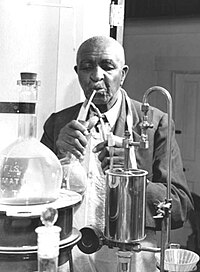
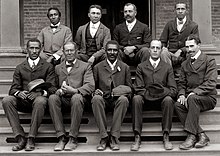
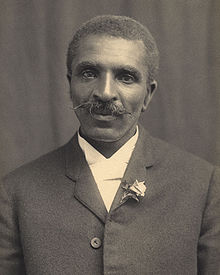
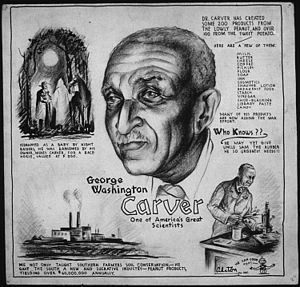
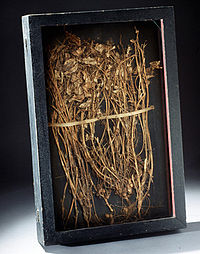
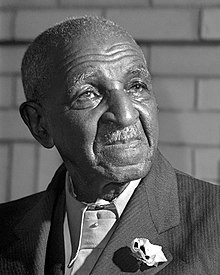

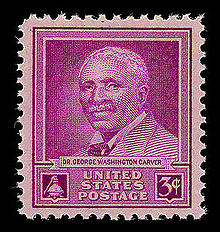
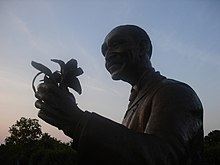
No comments:
Post a Comment